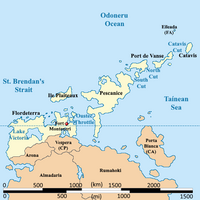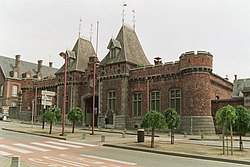Equatorial Ostiecia: Difference between revisions
mNo edit summary |
|||
| Line 19: | Line 19: | ||
|nickname = | |nickname = | ||
|motto = | |motto = | ||
|image_map = | |image_map = EO Administrative Map.png | ||
|map_alt = | |map_alt = | ||
|map_caption = | |map_caption = Provinces of Equitorial Ostiecia | ||
|pushpin_map = | |pushpin_map = | ||
|pushpin_map_alt = | |pushpin_map_alt = | ||
Revision as of 01:15, 17 September 2022
{wip}}
Equitorial Ostiecia
Burgoignesc Equitorial Ostiecia | |
|---|---|
 Provinces of Equitorial Ostiecia | |
| Nation | |
| Constituent Country | Equitorial Ostiecia |
| Government | |
| • Prince(ss)-President | Amethine-Ophelia IV |
| • Prime Minister | Pau-Evisan Estienne de Viersir |
| Area | |
| • Total | 488,678.957 km2 (188,680.000 sq mi) |
| • Water | 4,402.98 km2 (1,700.00 sq mi) |
| Population (2025) | |
| • Total | 64,578,249 |
| • Density | 132.14/km2 (342.2/sq mi) |
| Demonym(s) | Equitorioise |
Equitorial Ostiecia is a large constituent country of Burgundie located on the northern end of Vallos, at the confluences of the Odoneru Ocean, St. Brendan's Strait, the Taínean Sea, and the Polynesian Sea. In the last 50 years it has come be the cultural and economic center of Burgundie, in essence, creating a foil to the Burgoignesc Metropole.
It is home to over 64 million people and is an economic powerhouse with higher than average GDPPC and standards of living than any other constituent country of Burgundie. Equitorial Ostiecia is predominantly Merchantile Reform Protestant. The country upholds religious freedoms and there is a diversity of religions and other Christian Rites making up 34% of the population. The country is demographically diverse, with 64% of its population being "of Occidental descent" (of which 58% identify as Bergendii), 13% identify as "of Polynesian descent", 8% identify as "of indigenous Cronan descent", 7% identify as "of Oduniyyad descent", 5% identify as "of Alshari descent", and 3% identify as "of other origin" (it is suspected that they are mostly Coscivians). The majority of the people live in urbanized coastal areas, have exceedingly high rates of academic attainment, and work in the services sector.
Economically Equitorial Ostecia is led by its logistics/operations management. It also boasts a large manufacturing sector but this is largely automated so it does not account for a large portion of employment. Retail and the public sector follow manufacturing as economic drivers, they tend to be lower paying but they employ millions of Equitorioise. There is a niche agricultural sector that mostly focuses on cash crops like tea, coffee, sugarcane, cotton, and citrus. There is an even smaller livestock element of the economy with cattle and chickens being the two most commonly raised animals.
Equitorial Ostiecia has been a part of History of Burgundie from at least the early 1600s and after the collapse of the Burgoignesc Colonial Empire in Alshar and Audonia most of the Levantine protestants who made up those Pharisedoms relocated to Equitorial Ostiecia. From that point onward Equitorial Ostiecia has been considered a core part of Burgundie itself.
Geography
Geology
The islands of Equitorial Ostiecia, and the entire XX archipelago, were formed by a strike-slip fault as the Cronan plate and Sarepdonian plate intersect. It is a hotbed of volcanic activity.
Climate
Flora
Fauna
History
Geological history
Early settlements
Pre-Occidental history
Late modern period
As the Burgoignesc Colonial Empire collapsed in the early 1800s a massive influx of Bergendii colonists from Alshar and Audonia sought refuge. As they had been dismissed from Levantine for being Protestant in the first place, they were not welcomed back to the Burgoignesc Metropole.
They were rerouted, en masse to Equitorial Ostiecia were the population exploded from about 27,000 Occidentals in 1800 to about 450,000 by the 1850s. The colony saw an explosive period of urbanization and industrialization of farming to accommodate the seemingly endless tidal wave of people.
Because this was occurring during the industrial revolution there was period during the First Fratricide where Equitorial Ostiecia was more advanced than the Burgoignesc Metropole. Because the colony wants bound up in medieval infrastructure and political baggage it was able to adopt new ideas and technologies immediately.
This is also the period when the primacy of property rights, self-reliance, embracing innovation, and a frontier mentality took hold in Equitorial Ostiecia that still permeates it's culture today. The concepts of Equitorioise ingenuity and Equitorioise stoicism were born of this period.
Contemporary period
Second Great War
Operation Kipling
The wars of Operation Kipling formed the modern Equitorial Ostiecia. It was used as a forward operating base for the various general staffs and as a forward manufacturing and logistical hub. The logistical infrastructure that criss-crosses the country were laid down or expanded during the course of the wars in Alshar and Audonia. It is also why most of the infrastructure favors the western sides of the islands. The raw materials coming from the Burgoignesc Metropole were smaller and easier to disembark in the older ports and rail hubs in the eastern shores of Equitorial Ostiecia. As the products were assembled they became larger and more complex and by the time they were completed and ready to send to the war zones they required larger and more complex logistical chains. This has led to more rail and shipyards in the western portions of the country and more airfields as well.
1980s through today
After the conclusion of Operation Kipling the Security Services of Burgundie sold off much of the manufacturing and logistical assets it had built/subsidized to private firms who were immediately take ownership and turn a profit. This lead to a huge economic boom that lasted from about 1987-1995. It waned with the advent of the global adaptation of the internet but a few companies were forward thinking and invested heavily in the adoption of the new technology. The shipping company wars of the mid 90s ravaged large swathes of the economy to the point were the national government of Burgundie stepped in and mediated a peace and what had once been a patchwork of 100s of smaller owner/operator logistical concerns was reduced down to three large logistical companies to provide stability, maintain competition, and standardize the infrastructure to international standards.
This infrastructure standardization led to a construction and network system development boom that led the economy for approximately 15 years from 1998-2013. While construction and infrastructure maintenance is still a strong aspect of the economy, it is a mere shadow of itself in the early 2000s. Bringing all of the micro systems online or into a centralized corporate database meant that an entire sector needed to be stood up overnight. This also means that government-owned internet infrastructure was pervasive across all of Equitorial Ostiecia with fiber optic internet being standard and 4 and 5G towers covering 97% of the countries population.
Equitorial Ostiecia also was the first Levantia and Odoneru Treaty Association (LOTA) constituent to thaw relations with Caphiria and as such had virtually zero competition in the trade to and from Caphirian markets to consumers in LOTA countries. It also saw a rapid growth in the tourism sector as Caphirian tourists and tourists from LOTA nations would come and gawk at each other on "neutral" ground. Tourism has since subsided but it is still a popular destination for Yonderrians who want to get a sun burn without having to learn another language.
Companies in Equitorial Ostiecia used this revenue to expand their markets to nations on all continents and to diversify their internal economy as well.
Politics
Administrative divisions

The "mainland" province of Equitorial Ostiecia and its immediate surrounding islands is Flordeterra, its capital is Vilalbanes. It is the capital province of the country, with the federal government capitaled at Fort Monteneri. The largest island province is called Pescanice, its capital is Port de Vent. Isle Plaiteaux is the island province due north of Flordeterra, its capital is Portinhes. Port de Vanse is a cluster of islands northeast of Pescanice, its capital is Aprolpheia. The smallest province to the extreme north east is Catavis, its capital is Portilles.
Culture
Dance
Death
Sport
Film
Religion
Cuisine
Education
Economy
Employment
Mining
Tourism
Agriculture
Trade
Infrastructure
Maritime
Roads and rail
Air
Energy and electricity
Military installations
Equitorial Ostiecia is home to many military bases, Fort LaRemie, operated by and headquarters to the Foreign Legion, is the largest and most prominent.
Fort LaRemie
| Fort LaRemie Foreign Legion Command, | |
|---|---|
| | |
| Site information | |
| Owner | Burgoignesc Security Forces |
| Operator | Army of Burgundie |
| Controlled by | Burgoignesc Central Combined Forces Command, Equitorial Ostiecoise Sector |
| Condition | Operational |
| Site history | |
| Built | 1884 |
| Garrison information | |
| Occupants | Foreign Legion
|
 The military installation now know as Fort LaRemie was first established as a militia training camp in the 1600s under orders of the Bourgondii Royal Trading Company and used as a mustering ground for over 150 years. It was also a town common for grazing animals when not serving its military purpose. In the 1780s its militia use was discontinued. The grounds were eventually sold to a private land owner.
The military installation now know as Fort LaRemie was first established as a militia training camp in the 1600s under orders of the Bourgondii Royal Trading Company and used as a mustering ground for over 150 years. It was also a town common for grazing animals when not serving its military purpose. In the 1780s its militia use was discontinued. The grounds were eventually sold to a private land owner.
